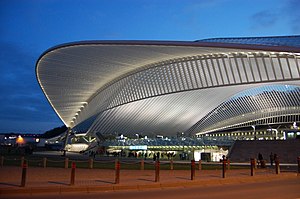Liège-Guillemins railway station
Liège-Guillemins | |
|---|---|
 | |
| General information | |
| Location | Place des Guillemins, Liège |
| Coordinates | 50°37′29″N 5°34′01″E / 50.62472°N 5.56694°E |
| Owned by | Infrabel |
| Operated by | National Railway Company of Belgium |
| Line(s) | 4, 34, 36, 37, 40, 43, 125 |
| Platforms | 5 |
| Tracks | 10 |
| History | |
| Opened | 1842-05-01 2009-09-18 |
| Rebuilt | 2009-09-18 |
| Passengers | |
| 2009 | 6.26 millions |
Liège-Guillemins railway station (IATA: XHN) is the main station of the city of Liège, the third largest city in Belgium. It is one of the most important hubs in the country and is one of the 3 Belgian stations on the high-speed rail network. The station is used by 15,000[1] people every day which makes it the eleventh busiest station in Belgium and the third in Wallonia.
History


In 1838, only three years after the first continental railway, a line linking Brussels and Ans, in the northern suburbs of Liège, was opened. The first railway station of Liège-Guillemins was inaugurated in May 1842, linking the valley to the upper Ans station. In 1843, the first international railway connection was born, linking Liège to Aachen and Cologne.
The station was modernised and improved in 1882 and in 1905 for the World Fair in Liège. This Beaux-Arts station was replaced in 1958 by a modern International style building that was used until June 2009, a few months before the opening of the new Calatrava-designed station. The second station was completely demolished to allow the completion of the remaining sections of the new station.
New station

At the end of the 20th century high speed trains were introduced but the platforms were too small and the station had a shabby appearance, so they built a new one. The new station, by the architect Santiago Calatrava, was officially opened on 18 September 2009, with a show by Franco Dragone. It has 9 tracks and 5 platforms (three of 450 m and two of 350 m). All the tracks around the station have been modernised to allow high speed arrival and departure.
The new station is made of steel, glass and white concrete. It includes a monumental arch, 160 metres long and 32 metres high.
The building costs were €312 million.
Services
Liège-Guillemins station is served by InterCity and InterRegio trains, connecting Liège with all major Belgian cities as well as several international destinations such as Aachen, Lille, and Maastricht. In addition to the national trains, Liège-Guillemins station welcomes Thalys and ICE trains, connecting Liège to Brussels, Paris, Aachen, Cologne and Frankfurt. Two new dedicated high-speed tracks were built: HSL 2 (Brussels-Liège) and HSL 3 (Liège-German border).
There are also plans for Eurostar and ICE to link Liège directly to London.[citation needed]
The station is served by the following services:
- High speed services (Thalys) Paris - Brussels - Liège - Aachen - Cologne - Düsseldorf - Essen - Dortmund
- High speed services (ICE) Brussels - Liège - Aachen - Cologne - Frankfurt
- Intercity services (IC-01) Ostend - Bruges - Gent - Brussels - Leuven - Liège - Welkenraedt - Eupen
- Intercity services (IC-09) Antwerp - Lier - Aarschot - Hasselt - Liège (weekends)
- Intercity services (IC-12) Kortrijk - Gent - Brussels - Leuven - Liège - Welkenraedt (weekdays)
- Intercity services (IC-13) Hasselt - Liers - Liège - Visè - Maastricht (weekdays)
- Intercity services (IC-13) Liège - Visè - Maastricht (weekends)
- Intercity services (IC-14) Quiévrain - Mons - Braine-le-Comte - Brussels - Leuven - Liège (weekdays)
- Intercity services (IC-18) Brussels - Namur - Liège (weekdays)
- Intercity services (IC-25) Mons - Charleroi - Namur - Huy - Liège (weekdays)
- Intercity services (IC-25) Mouscron - Tournai - Saint-Ghislain - Mons - Charleroi - Namur - Huy - Liège - Liers (weekends)
- Intercity services (IC-33) Liers - Liège - Rivage - Vielsalm - Troisvierges - Ettelbruck - Luxembourg
- Local services (L-01) Namur - Huy - Liège
- Local services (L-15) Liers - Liège - Esneux - Rivage - Marche-en-Famenne - Marloie
- Local services (L-17) Herstal - Liège - Pepinster - Verviers
- Local services (L-21) Waremme - Liege (weekdays)
- Local services (L-21) Landen - Waremme - Liege (weekends)
The national trains to Brussels also use the high speed track at 200 km/h, while the Thalys and ICE can go up to 300 km/h (bring Brussels at only 39' minutes from Liège).[2]
Road connections
Liège-Guillemins is also a transport hub for TEC Bus: more than 1620 buses, carrying 15,000 people, serve the station every day. It is one of the few railway stations in Europe directly connected to a motorway (E40-E25). The connection gives direct access to the 850-place parking structure, behind the station.[3] No cycling path connection exists between the station and the city.
See also
- High-speed rail in Belgium
- List of TGV stations
- National Railway Company of Belgium
- Rail transport in Belgium
References
- ^ (xls) SNCB Mobility. "Reizigerstellingen 2009" (in Dutch).
- ^ Emeric Massaut [@emassaut] (4 September 2012). "http://t.co/llDePao6" (Tweet) – via Twitter.
- ^ "Liège Guillemins - P1 : Parking Gare". Retrieved 20 October 2012.
External links
![]() Media related to Liège-Guillemins train station at Wikimedia Commons
Media related to Liège-Guillemins train station at Wikimedia Commons
- Official website
- "Guillemins station and discrit" (PDF). Archived from the original (PDF) on 2009-03-06.
{{cite web}}: Unknown parameter|deadurl=ignored (|url-status=suggested) (help) (353 KiB) - In Pictures: Calatrava's Liège-Guillemins train station

